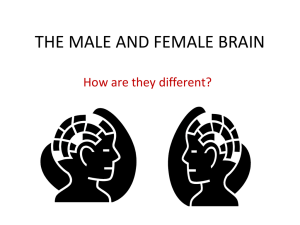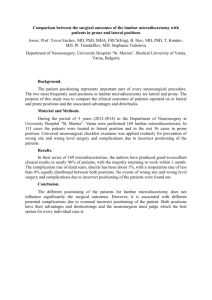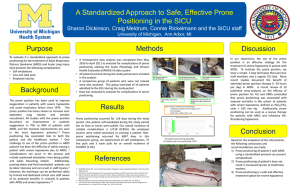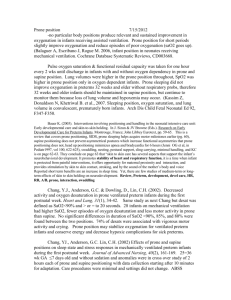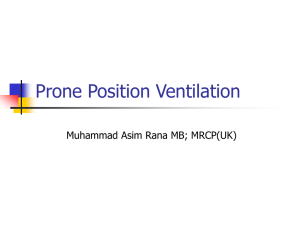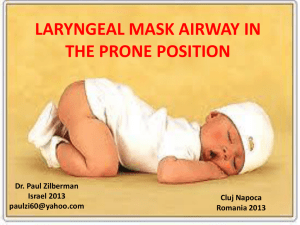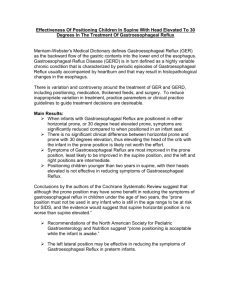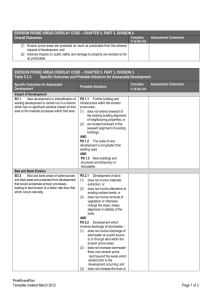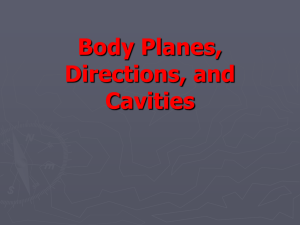Prone Position in Patients with ARDS
advertisement
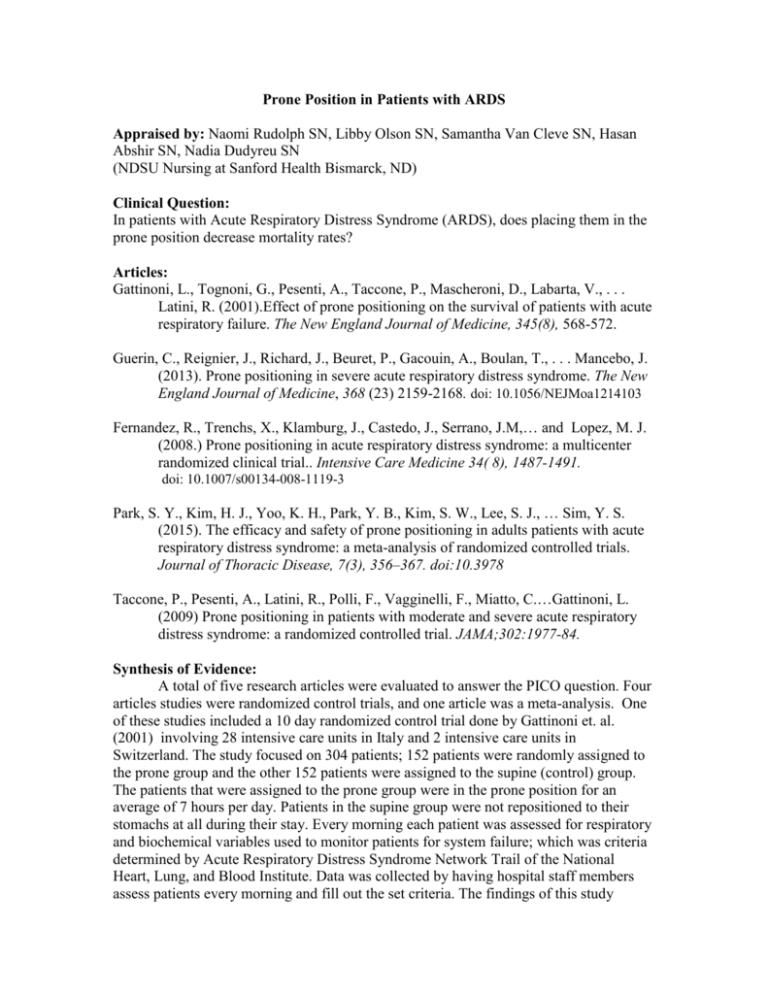
Prone Position in Patients with ARDS Appraised by: Naomi Rudolph SN, Libby Olson SN, Samantha Van Cleve SN, Hasan Abshir SN, Nadia Dudyreu SN (NDSU Nursing at Sanford Health Bismarck, ND) Clinical Question: In patients with Acute Respiratory Distress Syndrome (ARDS), does placing them in the prone position decrease mortality rates? Articles: Gattinoni, L., Tognoni, G., Pesenti, A., Taccone, P., Mascheroni, D., Labarta, V., . . . Latini, R. (2001).Effect of prone positioning on the survival of patients with acute respiratory failure. The New England Journal of Medicine, 345(8), 568-572. Guerin, C., Reignier, J., Richard, J., Beuret, P., Gacouin, A., Boulan, T., . . . Mancebo, J. (2013). Prone positioning in severe acute respiratory distress syndrome. The New England Journal of Medicine, 368 (23) 2159-2168. doi: 10.1056/NEJMoa1214103 Fernandez, R., Trenchs, X., Klamburg, J., Castedo, J., Serrano, J.M,… and Lopez, M. J. (2008.) Prone positioning in acute respiratory distress syndrome: a multicenter randomized clinical trial.. Intensive Care Medicine 34( 8), 1487-1491. doi: 10.1007/s00134-008-1119-3 Park, S. Y., Kim, H. J., Yoo, K. H., Park, Y. B., Kim, S. W., Lee, S. J., … Sim, Y. S. (2015). The efficacy and safety of prone positioning in adults patients with acute respiratory distress syndrome: a meta-analysis of randomized controlled trials. Journal of Thoracic Disease, 7(3), 356–367. doi:10.3978 Taccone, P., Pesenti, A., Latini, R., Polli, F., Vagginelli, F., Miatto, C.…Gattinoni, L. (2009) Prone positioning in patients with moderate and severe acute respiratory distress syndrome: a randomized controlled trial. JAMA;302:1977-84. Synthesis of Evidence: A total of five research articles were evaluated to answer the PICO question. Four articles studies were randomized control trials, and one article was a meta-analysis. One of these studies included a 10 day randomized control trial done by Gattinoni et. al. (2001) involving 28 intensive care units in Italy and 2 intensive care units in Switzerland. The study focused on 304 patients; 152 patients were randomly assigned to the prone group and the other 152 patients were assigned to the supine (control) group. The patients that were assigned to the prone group were in the prone position for an average of 7 hours per day. Patients in the supine group were not repositioned to their stomachs at all during their stay. Every morning each patient was assessed for respiratory and biochemical variables used to monitor patients for system failure; which was criteria determined by Acute Respiratory Distress Syndrome Network Trail of the National Heart, Lung, and Blood Institute. Data was collected by having hospital staff members assess patients every morning and fill out the set criteria. The findings of this study indicated there is no significant decrease in mortality rates. However, they did determine that placing the patient in the prone position improved oxygenation status by 70% after the first hour and may be beneficial to patients who are unable to maintain oxygenation saturation. There are not specific limitations to this study, however, they do recommend another study be conducted in order to provide more accurate data. Park et al. (2015) conducted a meta-analysis of 8 randomized control trials that took place in an adult intensive care unit. A total of 2,168 patients were included in this study. The intervention group of 1,099 was placed in prone positioning in conjunction with protective lung ventilation to decrease mortality in patients who suffer from severe acute respiratory distress syndrome or ARDS. The control-group of 1,042 was placed in the supine position. The results showed the patients placed in the prone position had a decrease in lung strain and stress. This is especially helpful for the patients who are severely hypoxemic. The included trials were somewhat diverse with variable in the severity of ARDS, the duration of the prone position, ventilation strategies, and associated treatment. Secondly, all relevant evidence may not have been included considering all the articles searched were limited to English. Lastly, the small number of trials available may have led to underestimation of the heterogeneity and less precise estimates of the pool-effect. Prone positioning is a relatively safe procedure if equipment and position change is handled with great care. Prone positioning demonstrated a reduction in mortality rates in patients with ARDS in conjunction with lung-protective strategies and longer duration of the position (>12hrs). This procedure should be prioritized, although additional large RCT’s are required to continue researching this intervention. Fernandez et al. (2008) conducted a randomized control trial in 17 Spanish medical surgical ICUs for period of 60 days to identify if prone position with patients with ARDS decreases the mortality rate. Participants in the study were forty mechanically ventilated adult patients with ARDS with the average age 54-55. The invention group included twenty one patients positioned in prone position while control group included nineteen patients positioned in supine position. Patients turned prone demonstrated an apparent increase oxygenation within six hours, and this increase reached statistical significance on day 3. Also, discovered was a 15% reduction in mortality in the prone group compared with supine (38% vs. 53%). Although this difference fits the projected survival advantage, it did not reach statistical significance due to the small sample. In addition, Taccone et al. (2009) conducted a randomized control trial at 25 different Intensive Care Unit facilities in Paris and Spain over a period of 28 days. A total of 342 patients diagnosed with ARDS were included in this study. The intervention group was 168 patients placed in prone position for twenty hours of each day. The control group was a group of 174 patients that remained in the supine position for the 28 day period. They were only able to be placed in prone position in emergencies. Sequential Organ Failure Assessment scores were calculated each day to assess how each patients’ organs were functioning in prone or supine position. The primary outcome that was measured was death from any cause. Investigators did not get to see outcome data until the end of the study. At the end of study it was concluded that mortality rates between the two groups had no significant difference because in a population of 342 people any mortality rate below 15% cannot be identified. The 72 hours allowed for enrollment may not have been favorable because sooner interventions would have been more effective. Lastly, a prospective multicenter randomized controlled trial conducted by Guerin (2013) over a 5 year period. Patients were recruited from 26 ICU in France and 1 in Spain. The purpose of this research was to identify if prone positioning would decrease the mortality rate in patients with ARDS versus supine positioning. The study included two groups. First group consisted of 229 patients assigned to supine positioning who remained in a semi-recumbent position during mechanical ventilation for 4 hours. The study included 237 patients assigned to the prone position who were turned to the prone position within the first hour after randomization. They were placed in a completely prone position for at least 16 consecutive hours with mechanical ventilation. In supine group, measurements were performed every 6 hours. In the prone group, measurements were taken just before the patient was turned back to the supine position, after 1 hour of prone positioning, just before the patient was turned back to the supine position, and 4 hours after the patient was returned to the supine position. A total of 31 cardiac arrest occurred in the supine group versus 16 in the prone group (P=0.02). Mortality rate at day 28 was significantly lower in the prone group than in the supine group and persisted at day 90. In conclusion, this trial showed that patients with ARDS and severe hypoxia could benefit from prone treatment when it is used early and relatively in long sessions. Bottom Line: Three out of the five studies concluded that there was no significant difference in regards to prone position and decreased mortality rates. The two other studies indicated a decreased mortality rate if patients with ARDS were placed in the prone position. Considering that half of the studies indicate no significant difference and the other half of the studies indicate that placing patients in the prone position does decrease the chances of mortality rates more studies need to be conducted. In conclusion, placing ARDS patients in the prone position is not going to harm them so we would recommend this intervention if our patient is not maintaining their oxygen saturation. Implications for Nursing Practice: Evidence suggests that we should place patients in the prone position if they are unable to maintain their oxygenation status. This may not decrease likelihood of mortality but evidence states that it will improve their oxygenation saturation. This occurs because the prone position allows the patients lungs to be at maximum expansion. This therapy should be assessed and reassessed often, as airway and breathing are included as our top nursing priorities.
